BY ROB FELD
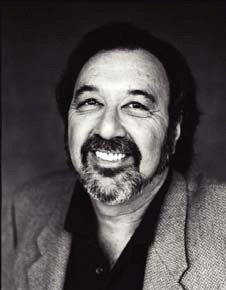 MOVED: Jim Brooks says the thing that
MOVED: Jim Brooks says the thing that
always gets him is the passion and
sense of purpose of the picture.
"This movie was done with a sense of enormous purpose," James L. Brooks says as we settle in his living room to watch William Wyler's 1946 seven-time Oscar winner,
The Best Years of Our Lives. "The writer, director and one of the stars had dropped their careers to work for the war effort. Everybody on the crew, by Wyler's insistence, was a veteran or had something to do with the war, so on the set there was great dedication to getting it right. The movie was about morality, and was made with extraordinary morality."
Brooks hasn't screened the film in decades and is anxious to rediscover what it was that has made it stay with him. "It's a picture that has always held part of my heart and lingers there. I just accept this movie as what America was. We were secure in our own goodness," he muses.
Wyler's 172-minute ensemble piece follows three veterans and their respective love interests, from the day they return home to Boone City after years of absence in World War II. Sgt. Al Stephenson (Fredric March) returns to his wife, Milly (Myrna Loy) and children, and soon starts work again at the bank he left when he joined the Army. Capt. Fred Derry (Dana Andrews) comes home from flyboy glory, jobless, to find that the lifestyle of his bride-cum-party girl Marie (Virginia Mayo), has suffered little while he's been away. And Seaman Homer Parrish (non-pro Harold Russell, a double-amputee from the war) returns to his family and fiancée with metal claws for hands, feeling like a burden.
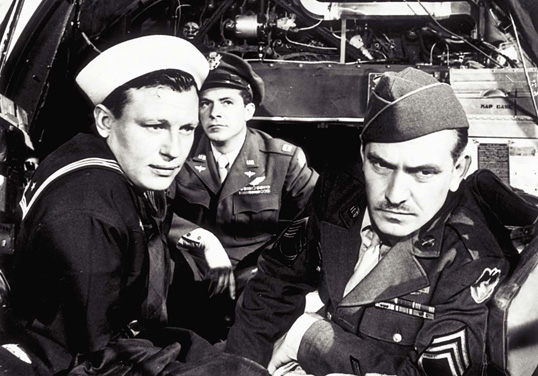 BACK TO REALITY: Returning soldiers (left to right) Harold Russell,
BACK TO REALITY: Returning soldiers (left to right) Harold Russell,
Dana Andrews and Fredric March bond in the crowded cockpit
of a B-17 bond on their way back to the States.
The film opens with Russell, hands hidden in the pockets of his peacoat, waiting for a flight home. "The reveal of his hands, here, is so important," Brooks says, immediately sucked in by Russell's naturalistic performance. "In the original book, the sailor was suffering from shell shock, but when they saw Russell in a documentary on the war they cast him and rewrote it for him. One day after dailies Wyler heard that Samuel Goldwyn, his boss, was giving Russell acting lessons and went crazy, insisting this is exactly the way this guy should and does behave."
"This scene is a model for getting exposition in," Brooks notes, as the returning soldiers cluster together in the nose cone of a B-17 Flying Fortress for over seven minutes of chatter. "He crowds them together, here–you'll also see that in another scene coming up." The men watch their country's landscape below and bond as only soldiers can, anticipating their new, changed lives. Homer lights cigarettes competently for the other two with his claws and tells the story of how he lost his hands, but his concern seeps through as he talks about his girl, who hasn't yet seen him.
Brooks, rubbing his chin, watches intently and is clearly moved by what he's seeing. "It's such a complicated scene to play. There's something about his rawness that makes you pay attention to the integrity of this piece. While making you uncomfortable it adds to the theater, but the lack of artifice is so important to the beginning of this picture. It says he's trying to tell the truth."
Brooks comments on Wyler's style of working with actors. "He was a guy who could do Funny Girl, Ben-Hur and this. He worked with Russell and left him alone to be himself, though when he worked with Laurence Olivier [in Wuthering Heights] they almost came to blows. Wyler successfully toned him down, and Olivier later thanked him for teaching him film acting."
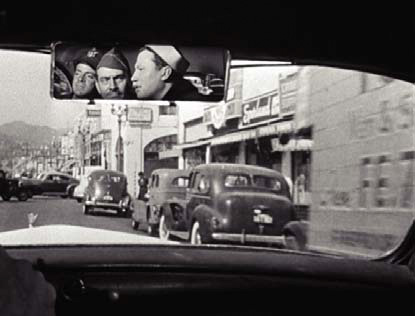 Wyler crowds the soldiers together in a three-shot in the
Wyler crowds the soldiers together in a three-shot in the
rearview mirror of a taxi.
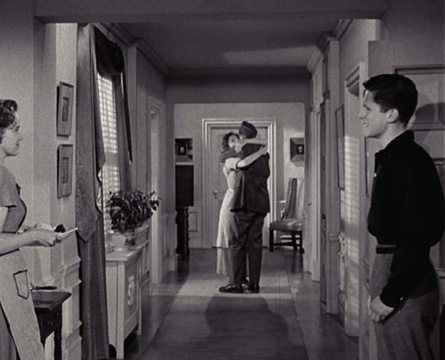
Myrna Loy embraces March as children Teresa Wright and
Michael Hall look on in one of the film's most famous shots.
Now sharing the back seat of a taxi home, the men's collective trepidation grows and Wyler shoots them in the rearview mirror, to get them into another three-shot. "The whole movie they're crowded in the frame," Brooks points out. "It's possible for the pace of a dated movie to just strangle you. But this doesn't seem slow, just unhurried." One by one the taxi drops the men at the doorsteps of their individual lives–working, middle and upper class, divisions made moot by their war experience.
Homer's face is haunted as they approach his house. "I wonder if Wilma's home," he muses. The others are silent. "It's so great," Brooks says. "You're so quickly into a big emotional scene. This could be the end of the movie coming up, and it just started." Brooks catches the repeated, subtle takes Homer's family does of his hands. "Wyler's so precise," Brooks explains. "You're in a master shot most of the time here, but your eye provides the close-ups; everyone's eyes are on the hooks, even as the actor concealed them, until finally, the mother, with the same consciousness we have, breaks into tears."
Next on the chopping block is Al, and Brooks gets excited. "Coming up is one of the most famous shots ever," he says. "Wyler had to do three of these homecomings in a row and this is a classic." Al rings the bell to his luxury apartment and quickly hushes his son and daughter's excitement as Myrna Loy calls obliviously from the other room, "Who was that at the door, Peggy?" Brooks laughs with anticipation. Al freezes at the sound of her voice, as Loy sets the table and comes to the realization of who it must be.
"It's so great how she turns here. Such extraordinary emotion to begin a picture. I mean, this is America, with a great point of view about the country." Loy drops the dishes and steps into the hall. The camera holds on Al's back as the couple sees each other for the first time. Slowly, Al travels to her and they embrace. "He needed a signature shot that had to burn into your memory, and he did it," he says. The kids step out of frame, the music swells and Wyler holds steady on the couple in the distance until the children return. Brooks revels in the family scene.
"You're on the verge of tears now. You feel somebody is telling us something from the warmest spot in their heart." Brooks quickly zeroes in on Loy, who with few words has suddenly become the film's gravitational center. "She had been categorized as a dramatic actress and was not prominent. Then she did The Thin Man series and her expertise in comedy allowed her to break through. Though this was definitely a re-establishment of her dramatic chops, she is intrinsically witty–the only one in the picture who is. And that's what makes it an all-time performance."
Once their initial exuberance wears off, Al and his wife become awkward. The camera doesn't do much work but Loy's glances tell all. "I just can't get over how brilliant she is. I haven't seen this in forever but you immediately accept her as the first character through which you can have a point of view towards the movie. She has so much going on and a magic voice–the instrument, itself. It's so amazing that you suddenly have an entry into the picture."
The action returns to the disabled veteran. As Homer sits uncomfortably while the family talks of his future, Brooks stays focused on the performances, particularly that of Cathy O'Donnell, who plays Homer's fiancée, Wilma. "I think this is her first part. It was really right to match Russell with somebody unsophisticated."
In the last of the homecomings, Dana Andrews (Fred) fails to find his gallivanting wife. He heads to the bar, where he soon reunites with Homer and Al, each seeking escape from their awkward family situations. Al has dragged his wife and daughter along for a drunken evening, providing endless fodder for Loy's sardonic glances. "She is all-knowing and you feel yourself totally in her shoes during this populated scene, even though she's had less than a page of dialogue so far. It's like the picture took the country on its lap and talked to it about what we all had to do now."
Fred, still not having found his wife, shares an immediate romantic chemistry with Al's daughter, Peggy (Teresa Wright), as they watch the revelry from a booth seat. "This is neat construction–the romance starting here," Brooks notes. "And, by the way, Wyler's delivery of an ensemble, of any number of characters that you immediately get interested in, is where you start getting masterful." Brooks continues to swoon over Loy. "There's one gal who can nail a joke, and right to camera," he laughs as Al drunkenly whirls her around the floor and she throws us a perfect eye-roll. "There's a story, which I don't think is apocryphal, about her and W.S. Van Dyke, who directed The Thin Man series. Again, she was thought of as a dramatic actress so she was a very unusual choice for it. She must have been up for the part and apparently at a party, he pushed her into a pool–and she came out with a witty, perfect Nora Charles reaction. [As a director] I wouldn't recommend doing that, but ..."
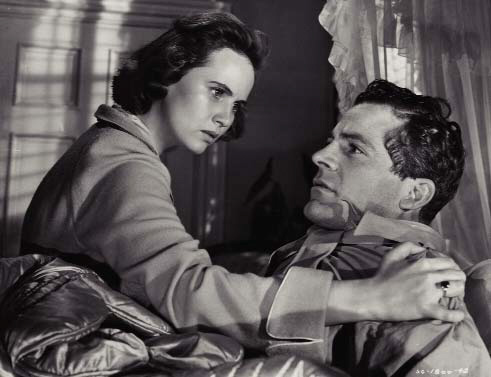 RELATIONSHIPS: Teresa Wright comforts Andrews waking
RELATIONSHIPS: Teresa Wright comforts Andrews waking
up from a nightmare.
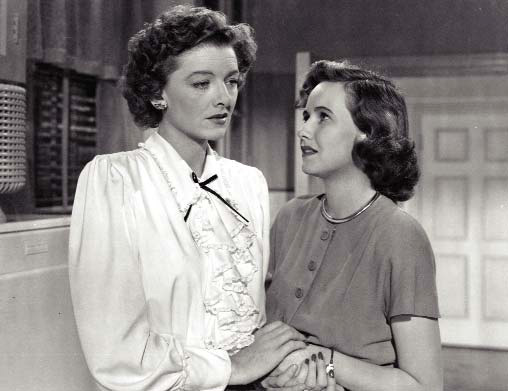
Loy and Wright even look like mother and daughter.
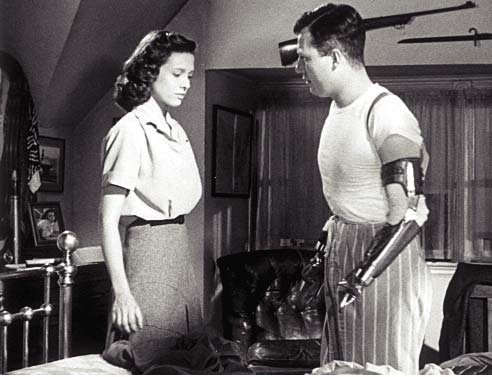
Amputee Russell reveals all for girlfriend Cathy O'Donnell.
The revelry ends and Milly and Peggy tuck their inebriated counterparts, Al and Fred, into bed, taking a mother/daughter moment to giggle together. Brooks himself lets out one of his resonant laughs, as he reacts joyously to one of his favorite film subjects: women, particularly in the context of family. "It's great they just shared a laugh, isn't it? And it's extraordinary to me, pre-feminism, pre-1950s and pre-Father Knows Best, for Chrissake, that these women are so strong."
The casting, here, is particularly skillful; from facial expression to voice inflection, Loy and Wright could plainly be mother and daughter. "There's something wonderful about all the little things they have in common," Brooks says. "It's almost like while you're watching Wright, you see what Loy was like when she was younger. I don't think I've ever seen that accomplished as well elsewhere."
Dana Andrews, taken in as a houseguest for the night, dreams of the war and his shouts wake Peggy in the next room. She rushes in to console him. Brooks shakes his head. "A man literally crying in his sleep–you ever see that anyplace? I'd forgotten it was in here. You never saw a woman clean tears from a man like that. You never saw it. And it's a stunning thought, isn't it? It gives you one of the things that all great films give to their audiences: you care enormously," he says as the tender scene fades out.
Things are strange for Al and Milly, who haven't rediscovered their footing or re-consummated their marriage yet. "It's so great that she's avoiding him, now," Brooks observes. "Aren't you feeling sexual tension in a way you never have in your life? You see what a fan Wyler was of behavior. I-I just..." Brooks stammers as Al finally grabs Milly and kisses her. "He does something like that and you love human beings. And you are one, for God's sake, so it's just some crazy route to a second of self love!"
Wyler follows the three families adjusting as best they can. Homer keeps Wilma at arm's length; Fred's marriage deteriorates as his presence and poor job prospects crimp his wife's style; and Al struggles to honor and help returning vets in his new position at the bank, overseeing small loans to ex-service men under the G.I. Bill, which his superiors see as particularly risky.
"The hallway sure is Wyler's friend," Brooks marvels as we return to Al's home to shoot him in a quiet moment of smoking and contemplation. "The stillness, I don't recall this at all. It's so funny to think this guy did Ben-Hur."
The story then provides one of its signature moments when Wilma finally confronts Homer, and he decides to show her what life with him and his disability would really mean, and so solemnly leads her upstairs to his room. "The relationship starts out so naive and becomes so powerful. All the previous uncomfortable moments with all the naturalness and truth the actor brought to them, suddenly makes for an unforgettable performance."
Russell explains his pre-bedtime ritual to Wilma and, for the first time, we see him remove his prosthetic arms. "This, I remember," Brooks says. "Wyler standing firm against Goldwyn to not make him into something else was a big deal. Wyler's fight with the boss was very likely imperative to the success of the film. He knew with this actor you don't go near the guy."
At the modest home wedding of Homer and Wilma, Fred is given a second chance at love. By this point his marriage is over and he and Peggy have had a painfully aborted romance. Now he and Peggy find themselves in the same room. "You know what's sort of great with Teresa Wright?" Brooks asks, as she talks to the man who broke her heart. "It's almost disturbing how the bloom has gone out of her. She was so full of life and she's just had the crap beat out of her, and she wears it."
As the wedding couple completes their vows in the master shot, everyone flows toward them, save Fred and Peggy, who move together and kiss. "It's pretty great," Brooks says. "If you had asked me after these decades, I would have talked about wonderful shots I remembered, but the thing that gets you is every participant's passion for the integrity of this picture. The high purpose and commitment.
"I thought all three love stories were amazing. Early in the film I started to feel how all the life went out of Peggy and Fred, Homer and Wilma, as they were kept apartÑwhich I think was all consciously and brilliantly done in more ways than we'll know. I'm sure every department had something to do with that. The film's focus on humanity and being so true to each individual story paid off. By making each tile so well observed about behavior and everything else, Wyler ended up having something to say about the human condition. But without Myrna Loy's wit the picture could have lost its perfect balance.
"Finally, though," Brooks concludes, "it was a very different acting company, one put together from absolute innocence to reigning world-class talent, all mixed together; an amateur like Russell with March, a leading theater actor of his day. And once you cast like that, Wyler's job becomes even more important because he's the one person holding it all together for a single purpose; the only one who came there with that single purpose. But he also insisted that everyone he worked with had shared the same experience and loved the people who fought a great and noble war. That's why we're looking at it 62 years later."